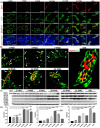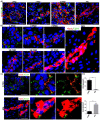Characterization of the pattern of expression of Gas1 in the kidney during postnatal development in the rat
- PMID: 37093844
- PMCID: PMC10124827
- DOI: 10.1371/journal.pone.0284816
Characterization of the pattern of expression of Gas1 in the kidney during postnatal development in the rat
Abstract
Growth Arrest-Specific 1 (Gas1) is a pleiotropic protein with different functions, in the adult kidney Gas1 acts as an endogenous inhibitor of cell proliferation but it is also necessary for the maintenance and proliferation of Renal Progenitor Cells (RPC) during early development, thus it fulfills important functions in the adult kidney. However, it is not known whether or not Gas1 is expressed during postnatal development, a critical stage for renal maturation. For this reason, the main objective of this work was to characterize the expression pattern of Gas1 in the different regions of the kidney by immunofluorescence and Western blot analysis during the postnatal development of the rat. We found that Gas1 is present and has a differential expression pattern in the various regions of the nephron during postnatal development. We observed that the highest levels of expression of Gas1 occur in the adult, however, Gas1 is also expressed in RPC and interestingly, the expression of RPC markers such as the Neural cell adhesion molecule (NCAM) and Cluster of differentiation 24 (CD24) were found to have an inverse pattern of expression to Gas1 (decreases as the kidney matures) during postnatal renal maturation, this indicates a role for Gas1 in the regulation of renal cell proliferation at this stage of development.
Copyright: © 2023 Cetina-Palma et al. This is an open access article distributed under the terms of the Creative Commons Attribution License, which permits unrestricted use, distribution, and reproduction in any medium, provided the original author and source are credited.
Conflict of interest statement
The authors have declared that no competing interests exist.
Figures








Similar articles
-
WT1 targets Gas1 to maintain nephron progenitor cells by modulating FGF signals.Development. 2015 Apr 1;142(7):1254-66. doi: 10.1242/dev.119735. Development. 2015. PMID: 25804736 Free PMC article.
-
Gas1 expression in parietal cells of Bowman's capsule in experimental diabetic nephropathy.Histochem Cell Biol. 2017 Jul;148(1):33-47. doi: 10.1007/s00418-017-1550-z. Epub 2017 Mar 18. Histochem Cell Biol. 2017. PMID: 28315934
-
Expression of growth arrest specific 1 (Gas1) in the distal tubules and collecting ducts in normal kidney and in the early stages of diabetic nephropathy.J Mol Histol. 2022 Dec;53(6):925-946. doi: 10.1007/s10735-022-10104-7. Epub 2022 Oct 22. J Mol Histol. 2022. PMID: 36272046
-
Gas1 is a pleiotropic regulator of cellular functions: from embryonic development to molecular actions in cancer gene therapy.Mini Rev Med Chem. 2014;14(14):1139-47. doi: 10.2174/1389557514666141127142301. Mini Rev Med Chem. 2014. PMID: 25429664 Review.
-
The role of Gas1 in embryonic development and its implications for human disease.Cell Cycle. 2007 Nov 1;6(21):2650-5. doi: 10.4161/cc.6.21.4877. Epub 2007 Aug 13. Cell Cycle. 2007. PMID: 17726382 Review.
References
-
- Dominguez-Monzon G, Gonzalez-Ramirez R, Segovia J. Molecular Mechanisms of Action of Gas1 and its Possible Therapeutic Applications. Curr Signal Transduct Ther. 2011;6(1), 106–112. doi: 10.2174/157436211794109433 - DOI
Publication types
MeSH terms
Substances
LinkOut - more resources
Full Text Sources
Research Materials
Miscellaneous

